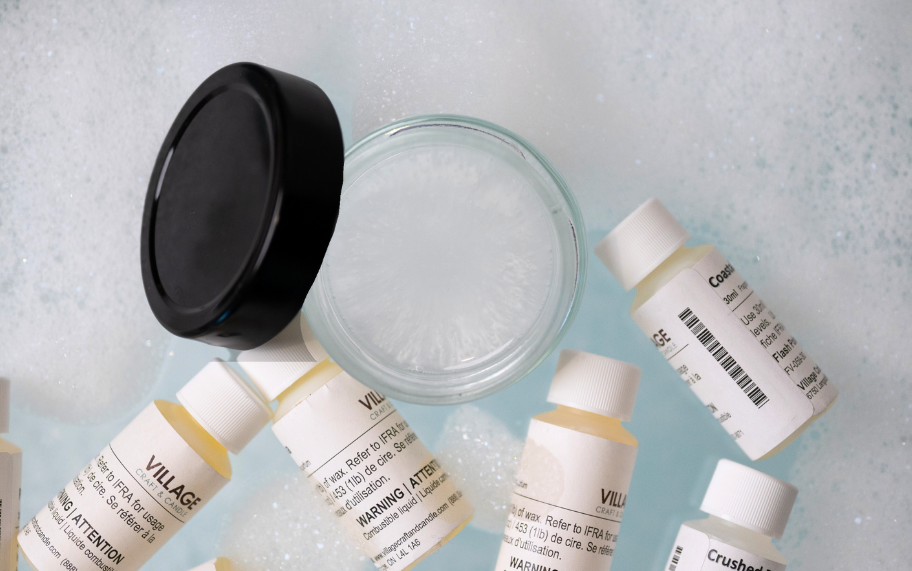6 Simple Steps in Making Liquid Soap with Fragrance Oils (Hand Soap & Body Wash)

The demand for gentle, high-quality liquid soaps has never been stronger. As customers look for better alternatives to harsh, store-bought options, makers and small business owners have a unique opportunity to offer something more nourishing, custom-scented, and thoughtfully crafted.
This guide is all about using ready-to-use liquid soap and body wash bases—no complicated chemistry, no dilution, no heating. Just blend, scent, colour (if you like), and bottle. Whether you're building your product line or creating your first batch, this breakdown will help you get it right from the start.
What You’ll Learn:
- The difference between hand soap and body wash
- What makes each base unique and how to use them
- How to scent, colour, and bottle your soaps
- Tips for troubleshooting and scaling your product
- Smart ways to market and grow your soap business
Let’s get started!
Hand Soap vs. Body Wash: What’s the Difference?
Although both are liquid cleansers, they serve slightly different purposes:
Hand Soap
- Designed for frequent washing
- Focuses on cleansing and bacteria removal
- May be less moisturizing
Body Wash
- Formulated for full-body use
- Includes more skin-conditioning ingredients
- Offers richer lather and a more luxurious feel
💡 Tip: Tweak your scents and branding to reflect the product’s purpose—fresh, crisp notes for hand soap and soft, luxurious blends for body wash.
Understand the Base Ingredients
1. Liquid Soap Base (Hand Soap)
- Ready to use—no dilution needed
- Enriched with chamomile, aloe vera, and green tea
- Fragrance-free, pre-preserved, pH-balanced
- Max fragrance load: 0.8% fragrance oil, 0.5% essential oil
2. Body Wash Base
- Also ready to use—no additional mixing required
- Formulated with silk amino acids, chamomile, aloe, and jojoba oil
- Sulfate-free, vegan, gentle for daily showers
- Max fragrance load: 0.5% fragrance oil, 0.4% essential oil
💡 Both are preserved and pH-balanced, which makes them shelf-stable as long as you stay within additive limits and don’t introduce water. The skin on your body is more sensitive than your hands, so body wash bases are made gentler with lower fragrance loads.
Safety & Hygiene Best Practices
- Sanitize all equipment before and after use
- Work in a clean, dry area
- Use only skin-safe, IFRA-compliant fragrance oils
- Clearly label your product and include usage instructions
- Recommend a patch test for first-time users
- Store finished soap in sealed containers, in a cool, dry place
🧼 Scent Blend Ideas for Liquid Soap Base (0.8% per 100ml)
| Blend Name | Fragrance Oil 1 | Amount | Fragrance Oil 2 | Amount | Fragrance Oil 3 | Amount |
|---|---|---|---|---|---|---|
| Citrus Sunrise | Sweet Orange | 0.3 ml | Lemon | 0.3 ml | Vanilla | 0.2 ml |
| Cozy Vanilla Woods | Vanilla | 0.4 ml | Cedarwood | 0.3 ml | Amber | 0.1 ml |
| Minted Lavender Clean | Mint | 0.4 ml | Lavender | 0.3 ml | Eucalyptus | 0.1 ml |
| Summer Sorbet | Strawberry | 0.4 ml | Raspberry | 0.3 ml | Coconut | 0.1 ml |
Max fragrance load: 0.8 ml per 100 ml batch (0.8%).
🚿 Scent Blend Ideas for Body Wash Base (0.5% per 100ml)
| Blend Name | Fragrance Oil 1 | Amount | Fragrance Oil 2 | Amount | Fragrance Oil 3 | Amount |
|---|---|---|---|---|---|---|
| Morning Dew | Cucumber | 0.2 ml | Aloe | 0.2 ml | Green Tea | 0.1 ml |
| Soft Citrus | Lemon | 0.25 ml | Sweet Orange | 0.2 ml | Vanilla | 0.05 ml |
| Calm & Clean | Lavender | 0.3 ml | Eucalyptus | 0.15 ml | Mint | 0.05 ml |
| Berry Breeze | Strawberry | 0.2 ml | Raspberry | 0.2 ml | Coconut | 0.1 ml |
Max fragrance load: 0.5 ml per 100 ml batch (0.5%).
💡 Note: Always use skin-safe, IFRA-compliant fragrance oils. Patch test before selling or gifting.
How to Make Liquid Soap with Fragrance Oils
1. Gather Your Ingredients & Tools
- Ready-to-use Liquid Soap Base or Body Wash Base
- Fragrance oil (skin-safe, within usage limits)
- Water-soluble dyes (optional)
- Clean container, spatula, pipettes or scale
- Sanitized pump or foamer bottles
2. Measure and Add Your Fragrance
- Pour your base into a clean container.
- Add fragrance oil according to your batch size:
| Batch Size | Max Fragrance (0.8% / 0.5%) |
|---|---|
| 100 ml | 0.8 ml (hand) / 0.5 ml (body) |
| 250 ml | 2.0 ml / 1.25 ml |
| 500 ml | 4.0 ml / 2.5 ml |
| 1 Litre | 8.0 ml / 5.0 ml |
💡 Because each fragrance oil is made up of different ingredients, some may fade more quickly than others. To help with this, consider using stronger base notes like vanilla or cedarwood for better retention.
3. Add Colour (Optional)
- Use only water-soluble dyes.
- Start small—one drop or a pinch—and adjust.
- Avoid micas, powdered pigments, or candle dyes.
- Some dyes may shift colour depending on pH.
💡 Choose stable, water-soluble dyes and store your soap in a cool, dark place. Additionally, use a darker bottle instead of a clear one, as clear bottles can allow UV light to affect the colour.
⚠️ Bright or dark dyes may stain porous tubs or cloths—test first.
4. Mix and Rest
- Stir slowly until the scent and colour are fully incorporated, avoiding vigorous mixing to prevent air bubbles.
- Allow the soap to rest, covered, for 12–24 hours to ensure a smooth consistency before bottling.
💡 Some fragrance and essential oils may cause this base to thin, thicken, or become cloudy. We recommend conducting performance testing to ensure the final product meets your desired results.
6. Bottle & Label
- Pour into sanitized bottles
- Let bubbles settle before sealing
- Label with batch date, scent name, ingredients
- Include usage and allergen disclaimers if selling
💬 Why Are There Bubbles? Mixing too fast traps air.
- Stir gently
- Let sit 12–24 hours
- Tap container lightly to release bubbles
Troubleshooting Common Issues
Here are some common issues you might run into while making your liquid soap—and how to fix them:
😕 My soap looks cloudy
- Fragrance oils can sometimes cause cloudiness in liquid soap, depending on their composition. This isn’t necessarily a problem.
- Fix: Let the soap rest for 12–24 hours—some cloudiness may settle or clear on its own. However, certain fragrance oils are known to stay cloudy, especially in clear bases. This is normal and does not affect the cleansing properties of the soap.
😖 The scent is way too strong
- You might have gone over the safe usage rate.
- Fix: Dilute by adding more unscented base in small amounts until it balances out.
😖 The scent faded quickly
- Fix: Add fragrance below 35°C. Because each fragrance oil is made up of different ingredients, some may fade more quickly than others. To help with this, consider using stronger base notes like vanilla or cedarwood for better retention.
🫧 There are lots of bubbles in my soap
- This usually happens from vigorous mixing.
- Fix: Stir slowly with a spatula. Let the soap rest uncovered for 12–24 hours so bubbles can rise and pop.
🌈 The colour faded or changed
- Some dyes react to pH or UV exposure.
- Fix: Choose stable, water-soluble dyes and store your soap in a cool, dark place. Additionally, use a darker bottle instead of a clear one, as clear bottles can allow UV light to affect the color.
🫧 Soap feels too thick or thin
- Some oils may affect viscosity.
- Fix: Avoid overmixing and measure fragrance carefully.
🧪 The pH is too high or low
- This can happen after adding ingredients.
- Fix: Use pH strips to test and adjust with citric acid (to lower) or sodium bicarbonate (to raise), a little at a time.
💡 Some fragrance oils may cause this base to thin, thicken, or become cloudy. We recommend conducting performance testing to ensure the final product meets your desired results.
Business Tips: Turning Your Soap Into a Profitable Product
Thinking of selling your soap? Here are some practical tips to help your products stand out!
1. Create Signature Scents & Collections
Customers love unique blends! Make seasonal collections or name each blend. For example:
- "Winter Walk" – pine + peppermint hand soap
- "Morning Bloom" – citrus-floral body wash
2. Invest in Good Packaging
- Use stylish, eco-friendly bottles that reflect your brand.
- Add clear, attractive labels with ingredients and scent stories.
- Include ingredient transparency to build customer trust.
3. Promote Creatively
- Share behind-the-scenes content on social media.
- Offer seasonal and limited-edition scents to encourage repeat purchases.
- Sell in bundles (e.g., hand soap + lotion combo) to increase sales.
Final Thoughts
Using a pre-preserved, ready-to-use base makes liquid soap making simple, reliable, and perfect for scaling. No heating, no dilution—just creativity and quality ingredients.
Where to Buy Supplies
🛒 Ready to make your own scented liquid soap? Check out Village Craft & Candle for premium soap bases, skin-safe fragrance oils, and everything else you need to craft with confidence.
🔥 Your perfect soap blend is just a bottle away—why not turn today’s experiment into tomorrow’s bestseller? Start your soap-making journey today at Village Craft & Candle.
Fragrance Oils and Health Products Our fragrance oils are intended for external use in candles, diffusers, and some cosmetic applications. They are not to be ingested, inhaled, or applied directly to skin without proper dilution. Health Canada requires a Natural Product Number (NPN) for the sale of any product making health claims or intended for therapeutic use. It is your responsibility to ensure your final product formulation complies with all applicable regulations and obtains the necessary NPN certification before sale.
Fragrance oils, when incorporated into health products, may require additional safety testing to ensure their suitability and interaction with other ingredients. We strongly recommend conducting independent testing by a qualified laboratory to confirm the safety and efficacy of your final product formulation. By purchasing this product, you agree to assume all responsibility for its proper use and application. We shall not be held liable for any misuse, claims, or damages resulting from the use of this fragrance oil in a health product.





